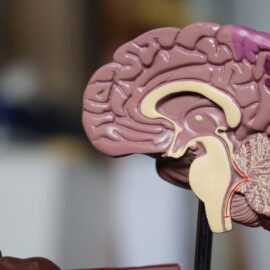

This article is an excerpt from the Shortform book guide to "A Brief History of Time" by Stephen Hawking. Shortform has the world's best summaries and analyses of books you should be reading.
Like this article? Sign up for a free trial here .
What is string theory? What conundrum does string theory attempt to resolve?
In physics, string theory states that the fundamental building blocks of the universe are one-dimensional strings as opposed to point-like particles. String theory attempts to solve one of the toughest stumbling blocks of physics—that is the difficulty of uniting the uncertainty principle with the predictions of general relativity.
Keep reading to learn about string theory, explained in simple terms.
String Theory, Explained
String theory replaces the concept of particles with strings—instead of a particle occupying a single point in space at a single point in time, there are strings occupying a line in space across each point in time. Thus, all points correspond to a time and to a position on the string.
Waves travel up and down the string, causing different strings to come together or split apart (a process analogous to particle collisions).
String theory explained the conditions of the universe better than rival theories—the main reason it garnered widespread scientific acceptance in the 1980s. One complication of string theories, however, is that they shatter the longstanding notion of four-dimensional space-time. For them to work at all, string theories require up to 26 dimensions of space-time. One example of these extra dimensions would be a donut-shaped universe, in which, to travel from point A to point B, one would need to travel around the inner ring of the donut. But the shortest possible route would actually be to travel through the center—a hitherto unimagined and inconceivable dimension!
We don’t see the extra dimensions because they are infinitesimally small. They are tiny warps or curves in space-time, far too small to be observable on a large scale (this also keeps string theory in harmony with the observation that the universe tends to be uniform on a large scale). Only the three spatial dimensions and one time dimension are flattened.
We can also appeal to the anthropic principle. Just two spatial dimensions would be insufficient to support life (the world would look like a side-scrolling video game, and blood circulation would be impossible). So would any more than three spatial dimensions, because they would destabilize the revolution of the Earth around the Sun. Thus, we observe our four flattened dimensions because those are the only regions of the universe where we can possibly exist.

———End of Preview———
Like what you just read? Read the rest of the world's best book summary and analysis of Stephen Hawking's "A Brief History of Time" at Shortform .
Here's what you'll find in our full A Brief History of Time summary :
- The search for a theory that explains the history and evolution of our universe
- Stephen Hawking's discussions about time, space, dimensions, and quantum theory
- How time travel would theoretically work






